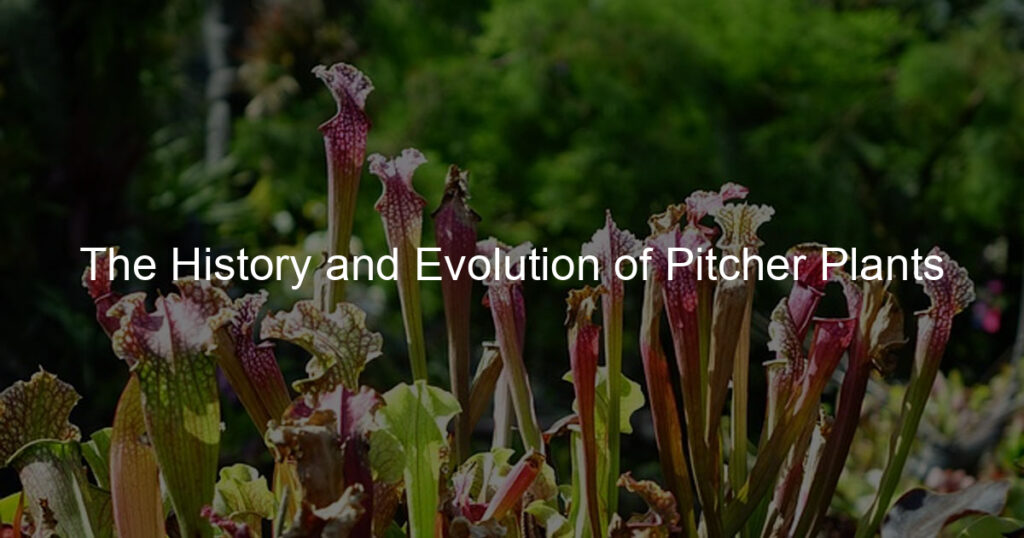Pitcher plants have long been a fascinating curiosity for plant lovers – their unique shape and ability to capture prey is truly something special. But how did these carnivorous curiosities come about? Are they still evolving today? With such diverse species ranging from the Nepenthes Rajah in Borneo to the Sarracenia purpurea found on the east coast of North America, you may be surprised by the answers to these questions!
What are pitcher plants?
Pitcher plants are fascinating carnivorous plants that grow in shallow boggy soil. They get their name from the large pitcher-like leaves they have which have evolved to trap and digest unsuspecting insects.
These mysterious plants are native to tropical and subtropical regions where they can be found growing in bright colors such as deep purples, pinks, and reds. They may look delicate but beneath their beauty lies a complex network of downward-facing hairs that act as one-way valves only allowing insects into the center of the plant and not back out again.
Inside the pitcher, digestive juices await their prey awaiting digestion. Pitcher plants are an incredible species perfectly adapted for their environment, and we should all appreciate them!
Where do pitcher plants originate from?
Pitcher plants are some of the most interesting and unique plants around! Originating from tropical Asia, Southeast Asia, and Australia, pitcher plants are an example of carnivorous plants that derive part of their nutrients from trapping and digesting insects.
These fascinating plants use the sugary liquid in the form of nectar or fluid secreted onto the lip of their ‘pitcher’ to attract the flying crawlers so they can be trapped inside!
The plant secretes digestive juices onto the insect from glands located inside its pitcher-shaped leaves, digesting them and eventually absorbing the necessary nitrogen for survival. Once it’s all said and done, what remains is a tiny meal for these killer plants. They’re pretty wild!
How do pitcher plants trap insects?
Pitcher plants are an incredible species of carnivorous plant that have a unique way of trapping insects. The most obvious tell-tale sign of pitcher plants is their special pitchers which are modified leaves!
Some scientists refer to them as “pitfall traps” because they look like colorful little cups with liquid inside. Insects that land on the edge of these “traps” slip in and can’t escape due to the downward-sloping walls and the slippery material on the top half of the inside.
The insects fall into a pool at the bottom where they drown–what a wild way for a plant to take advantage of its immediate environment! While we may think it sounds cruel, this amazing evolutionary mechanism is essential for these creatures to get their nutrients and minerals from their prey. Who knew such impressive biology would be lurking inside these pitcher plants?
What is the history of pitcher plants?
Pitcher plants have been around since ancient times, originating in Southeast Asia and Africa. These carnivorous plants derive nutrients from the insects they consume and are notable for their unique trapping mechanisms.
The most recognizable of these plants consists of a deep cup called a “pitfall trap” which is filled with liquid to drown their prey. They also contain a slippery wax-coated region that helps keep the insect inside, as well as nectar-filled tentacles to lure them in! Additionally, some pitcher plant species differ in their trapping mechanisms, having evolved to match the predators of their environment.
Despite being around since ancient times, it wasn’t until 1817 when John Kidner published his work detailing these fascinating creatures that they were widely recognized and admired. While we may not be able to fully understand why exactly pitcher plants have existed for so many years, we can marvel at and appreciate Nature’s gift to us all.
How have pitcher plants evolved?
Pitcher plants have evolved to become the fascinating and complex species they are today. Through millennia of change, pitcher plants have uniquely developed physical characteristics that allow them to thrive in otherwise inhospitable environments.
They’ve naturally adapted to living off of insects as their main source of nutrients, with an impressive array of special adaptations – from their slippery inner surfaces and sweet-smelling nectar to delicate hairs and downwards-facing pitchers to capture prey.
In addition, the coloration of the pitcher has changed from one species to another, ranging from green and white in some varieties, or even a deep red hue. Today we continue to be amazed by their capacity for adaptation in difficult environmental conditions – truly a marvel of nature!
What are the different types of pitcher plants?
Pitcher plants are an interesting and amazing species of carnivorous plant that can be found in tropical climates across the world. Although each pitcher plant species may vary in color, size, and appearance, what they all share in common is their remarkable biology.
The most common types of pitcher plants are the North American Purple Pitcher Plant (Sarracenia purpurea), the Cobra Plant (Darlingtonia californica), and the Monkey Cup (Nepenthes).
Each type of plant preys upon various insects by luring them inside special “pitchers” filled with digestive enzymes where they eventually perish from drowning or being broken down into nourishing materials for the plant. When it comes to pitcher plants, Mother Nature truly does provide some intriguing and clever solutions!
Conclusion
After learning a bit about pitcher plants and their history, we can’t help but appreciate these incredible natural wonders. While the waxy leaves and vibrant colors of these carnivorous species may just appear beautiful to us, they are so much more than their looks. These complex plants have many adapted features suitable for trapping victims in impressive ways and have proved useful over the years as botanists continue to study them.








